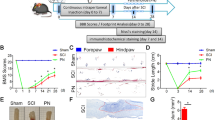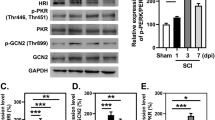Abstract
Traumatic spinal cord injury (SCI) is a devastating condition with few efficacious drugs. Sinomenine, a bioactive alkaloid extracted from medicinal herb, has been used as a treatment of rheumatoid diseases. This present study explored the therapeutic effects of sinomenine on locomotor dysfunction and neuropathology in SCI. Our findings revealed that sinomenine mitigated neurological deficits and enhanced neuronal preservation, paralleled with a reduction of apoptosis. Also, sinomenine significantly reduced inflammatory cytokines and oxidative stress factors. We further examined erythroid-2-related factor 2 (Nrf2) nuclear translocation, which mainly controls the coordinated expression of important antioxidant and detoxification genes. An increase in Nrf2 translocation from cytoplasm to nucleus and Nrf2-mediated transactivation was observed after sinomenine administration. Knocking down Nrf2 by siRNA could counteract sinomenine-mediated anti-oxidant stress and anti-inflammation following H2O2-stimulated and LPS-stimulated PC12 cells. Together, our findings indicated that sinomenine has the potential to be an effective therapeutic agent for SCI by inhibiting inflammation and oxidative stress via Nrf2 activation.








Similar content being viewed by others
References
Hong JY, Lee SH, Lee SC, Kim JW, Kim KP, Kim SM, Tapia N, Lim KT, Kim J, Ahn HS, Ko K, Shin CY, Lee HT, Scholer HR, Hyun JK, Han DW (2014) Therapeutic potential of induced neural stem cells for spinal cord injury. J Biol Chem 289:32512–32525
Zhang D, Xuan J, Zheng BB, Zhou YL, Lin Y, Wu YS, Zhou YF, Huang YX, Wang Q, Shen LY, Mao C, Wu Y, Wang XY, Tian NF, Xu HZ, Zhang XL (2017) Metformin improves functional recovery after spinal cord injury via autophagy flux stimulation. Mol Neurobiol 54:3327–3341
Khayrullina G, Bermudez S, Byrnes KR (2015) Inhibition of NOX2 reduces locomotor impairment, inflammation, and oxidative stress after spinal cord injury. J Neuroinflammation 12:172
Ozdemir US, Naziroglu M, Senol N, Ghazizadeh V (2016) Hypericum perforatum attenuates spinal cord injury-induced oxidative stress and apoptosis in the dorsal root ganglion of rats: involvement of TRPM2 and TRPV1 channels. Mol Neurobiol 53:3540–3551
Chen X, Chen X, Huang X, Qin C, Fang Y, Liu Y, Zhang G, Pan D, Wang W, Xie M (2016) Soluble epoxide hydrolase inhibition provides multi-target therapeutic effects in rats after spinal cord injury. Mol Neurobiol 53:1565–1578
Xun C, Mamat M, Guo H, Mamati P, Sheng J, Zhang J, Xu T, Liang W, Cao R, Sheng W (2017) Tocotrienol alleviates inflammation and oxidative stress in a rat model of spinal cord injury via suppression of transforming growth factor-beta. Exp Ther Med 14:431–438
Paterniti I, Impellizzeri D, Di Paola R, Esposito E, Gladman S, Yip P, Priestley JV, Michael-Titus AT, Cuzzocrea S (2014) Docosahexaenoic acid attenuates the early inflammatory response following spinal cord injury in mice: in-vivo and in-vitro studies. J Neuroinflammation 11:6
Qin T, Du R, Huang F, Yin S, Yang J, Qin S, Cao W (2016) Sinomenine activation of Nrf2 signaling prevents hyperactive inflammation and kidney injury in a mouse model of obstructive nephropathy. Free Rad Biol Med 92:90–99
Shi H, Zheng K, Su Z, Su H, Zhong M, He X, Zhou C, Chen H, Xiong Q, Zhang Y (2016) Sinomenine enhances microglia M2 polarization and attenuates inflammatory injury in intracerebral hemorrhage. J Neuroimmunol 299:28–34
Fan H, Shu Q, Guan X, Zhao J, Yan J, Li X, Liu J, Jia Z, Shi J, Li J (2017) Sinomenine protects PC12 neuronal cells against H2O2-induced cytotoxicity and oxidative stress via a ROS-dependent up-regulation of endogenous antioxidant system. Cell Mol Neurobiol 37:1387–1398
Qin T, Yin S, Yang J, Zhang Q, Liu Y, Huang F, Cao W (2016) Sinomenine attenuates renal fibrosis through Nrf2-mediated inhibition of oxidative stress and TGFbeta signaling. Toxicol Appl Pharmacol 304:1–8
Wu WN, Wu PF, Chen XL, Zhang Z, Gu J, Yang YJ, Xiong QJ, Ni L, Wang F, Chen JG (2011) Sinomenine protects against ischaemic brain injury: involvement of co-inhibition of acid-sensing ion channel 1a and L-type calcium channels. Br J Pharmacol 164:1445–1459
Yang Z, Liu Y, Yuan F, Li Z, Huang S, Shen H, Yuan B (2014) Sinomenine inhibits microglia activation and attenuates brain injury in intracerebral hemorrhage. Mol Immunol 60:109–114
Shukla SM, Sharma SK (2011) Sinomenine inhibits microglial activation by Abeta and confers neuroprotection. J Neuroinflammation 8:117
Mao L, Wang HD, Qiao LA, Wang XL (2010) Disruption of Nrf2 enhances the upregulation of nuclear factor-kappaB activity, tumor necrosis factor-alpha, and matrix metalloproteinase-9 after spinal cord injury in mice. Mediat Inflamm. https://doi.org/10.1155/2010/238321
Qin T, Du RH, Huang FJ, Yin SS, Yang J, Qin SY, Cao WS (2016) Sinomenine activation of Nrf2 signaling prevents hyperactive inflammation and kidney injury in a mouse model of obstructive nephropathy. Free Rad Biol Med 92:90–99
Fabrizio FP, Costantini M, Copetti M, la Torre A, Sparaneo A, Fontana A, Poeta L, Gallucci M, Sentinelli S, Graziano P, Parente P, Pompeo V, De Salvo L, Simone G, Papalia R, Picardo F, Balsamo T, Flammia GP, Trombetta D, Pantalone A, Kok K, Paranita F, Muscarella LA, Fazio VM (2017) Keap1/Nrf2 pathway in kidney cancer: frequent methylation of KEAP1 gene promoter in clear renal cell carcinoma. Oncotarget 8:11187–11198
Smith JR, Galie PA, Slochower DR, Weisshaar CL, Janmey PA, Winkelstein BA (2016) Salmon-derived thrombin inhibits development of chronic pain through an endothelial barrier protective mechanism dependent on APC. Biomaterials 80:96–105
Kao CH, Chen SH, Chio CC, Chang CK, Lin MT (2008) Exogenous administration of glial cell line-derived neurotrophic factor improves recovery after spinal cord injury. Resuscitation 77:395–400
Li HT, Zhao XZ, Zhang XR, Li G, Jia ZQ, Sun P, Wang JQ, Fan ZK, Lv G (2016) Exendin-4 enhances motor function recovery via promotion of autophagy and inhibition of neuronal apoptosis after spinal cord injury in rats. Mol Neurobiol 53:4073–4082
Kumar H, Ropper AE, Lee SH, Han I (2016) Propitious therapeutic modulators to prevent blood-spinal cord barrier disruption in spinal cord injury. Mol Neurobiol 54:3578–3590
Campolo M, Esposito E, Ahmad A, Di Paola R, Wallace JL, Cuzzocrea S (2013) A hydrogen sulfide-releasing cyclooxygenase inhibitor markedly accelerates recovery from experimental spinal cord injury. FASEB J 27:4489–4499
Cheng P, Kuang F, Zhang H, Ju G, Wang J (2014) Beneficial effects of thymosin beta4 on spinal cord injury in the rat. Neuropharmacology 85:408–416
Thompson CD, Zurko JC, Hanna BF, Hellenbrand DJ, Hanna A (2013) The therapeutic role of interleukin-10 after spinal cord injury. J Neurotrauma 30:1311–1324
Reigada D, Nieto-Diaz M, Navarro-Ruiz R, Caballero-Lopez MJ, Del Aguila A, Munoz-Galdeano T, Maza RM (2015) Acute administration of ucf-101 ameliorates the locomotor impairments induced by a traumatic spinal cord injury. Neuroscience 300:404–417
Long LH, Wu PF, Chen XL, Zhang Z, Chen Y, Li YY, Jin Y, Chen JG, Wang F (2010) HPLC and LC-MS analysis of sinomenine and its application in pharmacokinetic studies in rats. Acta Pharmacol Sin 31:1508–1514
Cai Y, Li J, Zhang Z, Chen J, Zhu Y, Li R, Chen J, Gao L, Liu R, Teng Y (2017) Zbtb38 is a novel target for spinal cord injury. Oncotarget 8:45356–45366
Yang Y, Wang H, Li L, Li X, Wang Q, Ding H, Wang X, Ye Z, Wu L, Zhang X, Zhou M, Pan H (2016) Sinomenine provides neuroprotection in model of traumatic brain injury via the Nrf2-ARE pathway. Front Neurosci 10:580
Chen L, Cui H, Fang J, Deng H, Kuang P, Guo H, Wang X, Zhao L (2016) Glutamine deprivation plus BPTES alters etoposide- and cisplatin-induced apoptosis in triple negative breast cancer cells. Oncotarget 7:54691–54701
Childs EW, Tharakan B, Hunter FA, Isong M, Liggins ND (2008) Mitochondrial complex III is involved in proapoptotic BAK-induced microvascular endothelial cell hyperpermeability. Shock 29:636–641
Tsai MJ, Liao JF, Lin DY, Huang MC, Liou DY, Yang HC, Lee HJ, Chen YT, Chi CW, Huang WC, Cheng H (2010) Silymarin protects spinal cord and cortical cells against oxidative stress and lipopolysaccharide stimulation. Neurochem Int 57:867–875
Choi JY, Hwang CJ, Lee HP, Kim HS, Han SB, Hong JT (2017) Inhibitory effect of ethanol extract of Nannochloropsis oceanica on lipopolysaccharide-induced neuroinflammation, oxidative stress, amyloidogensis and memory impairment. Oncotarget 8:45517–45530
Agostini M, Annicchiarico-Petruzzelli M, Melino G, Rufini A (2016) Metabolic pathways regulated by TAp73 in response to oxidative stress. Oncotarget 7:29881–29900
Pei JP, Fan LH, Nan K, Li J, Dang XQ, Wang KZ (2017) HSYA alleviates secondary neuronal death through attenuating oxidative stress, inflammatory response, and neural apoptosis in SD rat spinal cord compression injury. J Neuroinflammation 14:97
Zhang R, Xu M, Wang Y, Xie F, Zhang G, Qin X (2016) Nrf2-a promising therapeutic target for defensing against oxidative stress in stroke. Mol Neurobiol 54:6006–6017
Deng J, Lei C, Chen Y, Fang Z, Yang Q, Zhang H, Cai M, Shi L, Dong H, Xiong L (2014) Neuroprotective gases–fantasy or reality for clinical use? Progress Neurobiol 115:210–245
Zhang Q, Wang J, Zhang C, Liao S, Li P, Xu D, Lv Y, Yang M, Kong L (2016) The components of Huang-Lian-Jie-Du-Decoction act synergistically to exert protective effects in a rat ischemic stroke model. Oncotarget 7:80872–80887
Mao L, Wang H, Qiao L, Wang X (2010) Disruption of Nrf2 enhances the upregulation of nuclear factor-kappaB activity, tumor necrosis factor-alpha, and matrix metalloproteinase-9 after spinal cord injury in mice. Mediat Inflamm 2010:238321
Satoh T, Okamoto SI, Cui J, Watanabe Y, Furuta K, Suzuki M, Tohyama K, Lipton SA (2006) Activation of the Keap1/Nrf2 pathway for neuroprotection by electrophilic [correction of electrophillic] phase II inducers. Proc Natl Acad Sci USA 103:768–773
Shah ZA, Li RC, Thimmulappa RK, Kensler TW, Yamamoto M, Biswal S, Dore S (2007) Role of reactive oxygen species in modulation of Nrf2 following ischemic reperfusion injury. Neuroscience 147:53–59
Yin Q, Xia Y, Wang G (2016) Sinomenine alleviates high glucose-induced renal glomerular endothelial hyperpermeability by inhibiting the activation of RhoA/ROCK signaling pathway. Biochem Biophys Res Commun 477:881–886
Kumar H, Jo MJ, Choi H, Muttigi MS, Shon S, Kim BJ, Lee SH, Han IB (2017) Matrix metalloproteinase-8 inhibition prevents disruption of blood-spinal cord barrier and attenuates inflammation in rat model of spinal cord injury. Mol Neurobiol 55:2577–2590
Genovese T, Mazzon E, Crisafulli C, Di Paola R, Muia C, Bramanti P, Cuzzocrea S (2006) Immunomodulatory effects of etanercept in an experimental model of spinal cord injury. J Pharmacol Exp Therap 316:1006–1016
Wang AL, Li Z, Yuan M, Yu AC, Zhu X, Tso MO (2007) Sinomenine inhibits activation of rat retinal microglia induced by advanced glycation end products. Int Immunopharmacol 7:1552–1558
Acknowledgements
This work was supported by the Science and technology project of the National Natural Science Foundation of China (NO. 81401162), the Public Technology Research Program of Zhejiang Province (LGF18H060011) and Science and Technology Planning Program of Taizhou City (1702KY04).
Author information
Authors and Affiliations
Corresponding authors
Ethics declarations
Conflict of interest
The authors declare no conflict of interest.
Ethical Approval
All applicable international, national, and/or institutional guidelines for the care and use of animals were followed.
Additional information
Publisher’s Note
Springer Nature remains neutral with regard to jurisdictional claims in published maps and institutional affiliations.
Rights and permissions
About this article
Cite this article
Zhang, L., Zhang, W., Zheng, B. et al. Sinomenine Attenuates Traumatic Spinal Cord Injury by Suppressing Oxidative Stress and Inflammation via Nrf2 Pathway. Neurochem Res 44, 763–775 (2019). https://doi.org/10.1007/s11064-018-02706-z
Received:
Revised:
Accepted:
Published:
Issue Date:
DOI: https://doi.org/10.1007/s11064-018-02706-z




